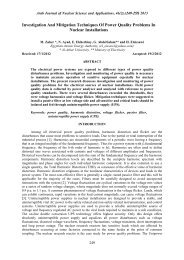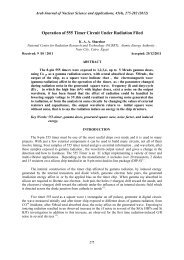Download - Arab Journal of Nuclear Sciences and Applications
Download - Arab Journal of Nuclear Sciences and Applications
Download - Arab Journal of Nuclear Sciences and Applications
You also want an ePaper? Increase the reach of your titles
YUMPU automatically turns print PDFs into web optimized ePapers that Google loves.
<strong>Arab</strong> <strong>Journal</strong> <strong>of</strong> <strong>Nuclear</strong> Science <strong>and</strong> <strong>Applications</strong>, 46(1), (359-373) 2013<br />
Table (1): plotting position formulas<br />
Name Source Relationship (Fi)<br />
Hosking <strong>and</strong> Wallis Hosking <strong>and</strong> Wallis (i-0.35)/n<br />
Hazen Hazen (i-0.5)/n<br />
Gringorten Gringorten (i-0.44)/(n+0.12)<br />
Cunnane Cunnane (i-0.4)/(n+0.2)<br />
Blom Blom (i-0.375)/(n+0.25)<br />
Filliben Filliben (i-0.3175)/(n+0.365)<br />
Benard Benard (i-0.3)/(n+0.4)<br />
Weibull Weibull i/(n+1)<br />
3. Probability plot<br />
The probability plot is a graphical technique for assessing whether or not a data set follows a<br />
given distribution. The data are plotted against a theoretical distribution in such a way that the points<br />
should form approximately a straight line. The estimates <strong>of</strong> the two parameters <strong>of</strong> distributions can be<br />
found graphically using the probability plot. The correlation coefficient (PPCC) associated with the<br />
linear fit to the data in the probability plot is a measure <strong>of</strong> the goodness <strong>of</strong> the fit. Estimates <strong>of</strong><br />
the location <strong>and</strong> scale parameters <strong>of</strong> the distribution are given by the intercept <strong>and</strong> slope. Probability<br />
plots can be generated for several competing distributions to see which provides the best fit, <strong>and</strong> the<br />
probability plot generating the highest correlation coefficient is the best choice since it generates the<br />
straightest probability plot.<br />
To construct the probability plot the observed data xi are ranked in ascending order, <strong>and</strong> denoted<br />
from x1:n to xn:n, where n is the total number <strong>of</strong> observations. A plotting position <strong>of</strong> the non-exceedance<br />
probability :<br />
ˆ F in is computed for each xi:n using some formulas <strong>of</strong> plotting positions. Parameters for the<br />
compared distributions are computed using the regression scheme. The regression (graphical) method<br />
starts with the data in levels, xi or logs, lnxi. Let Fˆ i is probability position. The horizontal axis (g ( F ˆ<br />
i ))<br />
is a transformation <strong>of</strong> F ˆ<br />
i (the reduce variate). The slope <strong>and</strong> intercept (denoted a <strong>and</strong> b), in the<br />
relationship between g( F ˆ<br />
i ) <strong>and</strong> xi (in levels or logs), correspond to the parameters <strong>of</strong> the model. The<br />
quantiles function <strong>of</strong> the distributions is given by:<br />
xp = a g ( F ˆ<br />
i ) +b (15)<br />
Lnxp = a g( F ˆ<br />
i ) +b (16)<br />
where xp (expected wind speed) is the quantiles function <strong>of</strong> the distributions.<br />
The correlation coefficient (PPCC) measures the strength <strong>of</strong> a linear relationship between two<br />
variables. Hence the correlation <strong>of</strong> xpi <strong>and</strong> g( ˆ i<br />
F ) might be a good way to measure how well each<br />
distribution fits the data. Table 2 shows the coordinates <strong>of</strong> X-axis <strong>and</strong> Y-axis <strong>of</strong> linear relationships<br />
(probability plots) <strong>of</strong> the compared probability distributions.<br />
362












